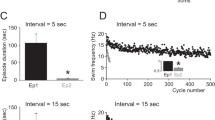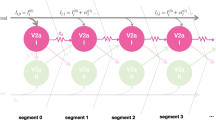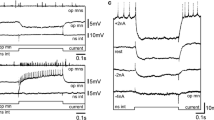Summary
A recently discovered member of the neuronal oscillator underlying swimming movements in the medicinal leech,Hirudo medicinalis, is described. This interneuron, named cell 60, exhibits membrane potential oscillations that are phase-locked to the swim oscillations observed in other oscillator neurons (phase angle, approximately 220°) and, when depolarized, acts to shift the phase of the swim oscillations. The soma of cell 60 lies near the posterior-lateral margin on the ventral aspect of most (and possibly all) segmental ganglia. The neurite crosses the midline, then turns anteriorly and projects into the lateral intersegmental connective. Cell 60 is connected to cell 28, a previously described dorsal swim oscillator neuron, via an electrically rectifying junction.
Two interactions link cell 60 with cell 208, a swim oscillator neuron found on the ventral aspect of segmental ganglia: a short-latency, fatiguing inhibitory synapse and a powerful electrical interaction. The electrical interaction acts as a diode, in that current can pass from cell 60 to cell 208, but not in the reverse direction. The coupling coefficient in the forward direction is about 0.5 and is independent of the membrane potential difference between cells 60 and 208 provided that the ‘diode’ connection is forward biased.
The rectifying junction acts as a switch which is ‘off’ during swimming activity because cell 208 oscillations are superimposed on a tonic depolarization of about 10–15 mV. This tonic potential reverse biases the electrical ‘diode’ connection between cell 60 and cell 208, leaving the inhibitory synapse as the only effective interaction between these cells. The diode switch is ‘on’ when cell 208 is hyperpolarized. In this circumstance, the dominant connection is electrical; therefore induced potential oscillations in cell 60 induce in-phase oscillations in cell 208.
Similar content being viewed by others
Abbreviations
- PIR :
-
Postinhibitory rebound
- NM :
-
Neuromime
References
Bennett MVL (1972) A comparison of electrically and chemically mediated transmission. In: Pappas GD, Purpura DP (eds) Structure and function of synapses. Raven, New York, pp 221–256
Berry MS, Pentreath VW (1976) Criteria for distinguishing between monosynaptic and polysynaptic transmission. Brain Res 105:1–20
Friesen WO (1981) Physiology of water motion detection in the medicinal leech. J Exp Biol 92:255–275
Friesen WO (1982) Electrical coupling and uncoupling of leech swim oscillator neurons via rectifying electrical synapses. Neurosci Abstr 8:161
Friesen WO, Poon M, Stent GS (1976) An oscillatory neuronal circuit generating a locomotory rhythm. Proc Natl Acad Sci USA 73:3734–3738
Friesen WO, Poon M, Stent GS (1978) Neuronal control of swimming in the medicinal leech. IV. Identification of a network of oscillatory interneurons. J Exp Biol 75:25–61
Furshpan EJ, Potter DD (1959) Transmission at the giant motor synapses of the crayfish. J Physiol (Lond) 145:289–325
Giaume C, Korn H (1983) Bidirectional transmission at the rectifying electrotonic synapse: A voltage-dependent process. Science 200:84–87
Granzow BL, Friesen WO, Kristan WB Jr (1985) Physiological and morphological analysis of synaptic transmission between leech motor neurons. J Neurosci (in press)
Kristan WB Jr, Calabrese RL (1976) Rhythmic swimming activity in neurones of the isolated nerve cord of the leech. J Exp Biol 65:643–668
Kristan WB Jr, Stent GS, Ort CA (1974) Neuronal control of swimming in the medicinal leech. I. Dynamics of the swimming rhythm. J Exp Biol 94:97–121
Macagno ER (1980) Number and distribution of neurons in the leech segmental ganglion. J Comp Neurol 190:283–302
Mitchell CE, Friesen WO (1981) A neuromime system for neural circuit analysis. Biol Cybern 40:127–137
Nicholls JG, Purves D (1970) Monosynaptic chemical and electrical connexions between sensory and motor cells in the central nervous system of the leech. J Physiol (Lond) 209:647–667
Nicholls JG, Wallace BG (1978) Quantal analysis of transmitter release at an inhibitory synapse in the C.N.S. of the leech. J Physiol (Lond) 281:171–185
Ort CA, Kristan WB Jr, Stent GS (1974) Neuronal control of swimming in the medicinal leech. II. Identification and connections of motor neurons. J Comp Physiol 94:121–154
Pearce RA, Friesen WO (1984) Intersegmental coordination of leech swimming: Comparison of in situ and isolated nerve cord activity with body wall movement. Brain Res 299:363–366
Smith RJ (1976) Circuits, devices, and systems. Wiley, New York, p 299
Stent GS, Kristan WB Jr, Friesen WO, Ort CA, Poon M, Calabrese RL (1978) Neuronal generation of the leech swimming movement. Science 200:1348–1357
Weeks JC (1982) Synaptic basis of swim initiation in the leech. II. A pattern-generating neuron (cell 208) which mediates motor effects of swim-initiating neurons. J Comp Physiol 148:265–279
Author information
Authors and Affiliations
Rights and permissions
About this article
Cite this article
Friesen, W.O. Neuronal control of leech swimming movements: interactions between cell 60 and previously described oscillator neurons. J. Comp. Physiol. 156, 231–242 (1985). https://doi.org/10.1007/BF00610866
Accepted:
Issue Date:
DOI: https://doi.org/10.1007/BF00610866




